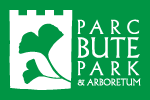The People’s Door, Bute Park

Press play for RNIB audio presentation
Or, download mp3 (868KB)
The oak door leading to the courtyard of the park's Education Centre and the Secret Garden Café is a work of art. Or, to be precise, several works of art. In early 2011 amateur and professional wood carvers were invited to submit their designs for carved door panels which would reflect the park’s rich heritage.

The People's Door
The main structure of the door, including its hefty iron hinges, was designed by Cardiff-born architect Michael Davies. Nine square panels were set aside for the winners of the carving competition. In February 2011, each shortlisted entrant collected a piece of oak measuring 23cm x 28cm and had a month to complete their artwork.
The entered pieces were then displayed as part of a temporary exhibition and members of the public invited to vote for their favourites. The winning pieces were then fabricated into the door by a local blacksmith and joiner. Allowed to weather naturally, the door now shows the marks of a chemical reaction between tannins in the oak and the iron of the hinges. It brings many lost features and stories back into the public domain.
The door was carefully lifted into position in August 2011 and formed the focal point for the opening ceremony of the education centre in October 2011.
Can you work out the story or historic feature behind each panel? If you’re part way through the HistoryPoints tour of Bute Park, you should have picked up some clues by now!
See the footnotes for the carvers’ names and the story behind the panel images.
Footnotes: What the panels depict
Top row, left to right:
Hermit, by Will Power (a long-standing member of the city’s park grounds maintenance team). There was a hermitage at the east end of the old Cardiff Bridge in the late 15th century. Its resident hermit lived on local people’s donations.
Swiss Bridge, by Arthur Welsby. A covered wooden bridge, inspired by the bridge at Lucerne, Switzerland, was built abutting Cardiff Castle in 1875-1878. Designed by William Burges, it gave the Bute family a pleasant route from their living quarters to their gardens.
Andrew Pettigrew, by Sharon Littley. Pettigrew was head gardener at the castle from 1873 to 1901. His landscaping shaped the park we see today and he was tasked with growing vines on the castle’s south wall.
Middle row:
Mill leat, by Barry Onslow. Two corn mills stood west of the castle in the 12th century. A fulling mill was added by 1314. The mill leat took water from the Taff to power the mills. It later formed the basis of the dock feeder, the channel along the east of the park.
Cottage industries, by Edmundo Ferreira-Rocha (Park Urban Ranger). Industries located in the park area in the 18th century included an ironworks, copper works and tanyard (treating animal skins to make leather). In the 19th century, ropes were made in a long, narrow field known as the rope walk.
A Blackfriar, by Michael Davies (architect employed by the Bute Park Restoration Project to restore the Animal Wall, West Lodge and build the new Education Centre). Blackfriars’ Friary was founded in 1256 by Richard de Clare, son of King Henry I. Dominican monks were known as “black friars” after their dark hoods, as depicted here in metal.
Bottom row:
Ducking stool, by Betsan Dunn. A ducking stool was erected north of Cardiff Bridge in 1739. It featured a long wooden arm with a chair attached. “Obnoxious” women would be strapped to the chair and ducked in the river several times. Men remained dry, no matter how obnoxious!
Coracles, by Robert Innes. Coracles are small fishing boats made of skin stretched over frames of bent willow. One family living at Blackweir farmhouse in the 1830s used coracles to fish the Taff. Can you find the coracle-inspired sculpted seat alongside the river today?
Roman coins, by Barry Onslow. Roman coins have been found in Bute Park. Two were unearthed north of the castle in 1985 and found to date from c.87AD.
Thanks to RNIB for the audio presentation of this page

